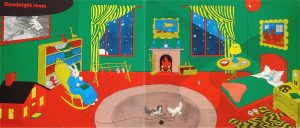One theme that struck me as I was reading The Arrival by Shaun Tan was that throughout the book, there would be a number of illustrations that were believable for depicting everday life, and then there would be a few fantastical images interspersed between them. The distinction between the two types of images caught my eye as I was thinking about Tan’s definition of what it means to photograph through his illustrations. In the opening illustrations, Tan shows images of the family that would be expected to occur in everyday life. These images convey the emotions that the family was feeling and he does it in a way that successfully represents how a photographer would approach capturing these scenes. As the family begins walking through the city, the shadow of a large creature follows along:
This image is interesting because if a photographer was capturing this scene in real life, there would still be shadows in the image, but the shadows would be from other buildings and not a creature. Tan converts this image into the fantastic by transforming the shadows into something scary, the tail of a monster, that he never shows the full form of. This leaves the identity of the monster up to the audience, who have the ability to transform it into something extremely scary. The shadow of the monster parallels the worry felt by the family over the unknown as the father travels to a new country to find work.
Based on Tan’s work, it seems that he believes a good photograph can capture both the obvious and subtle aspects of emotion and desire. His incorporation of the fantastic and dreams that the characters have suggests that it is possible to capture these thoughts in a real photography.



